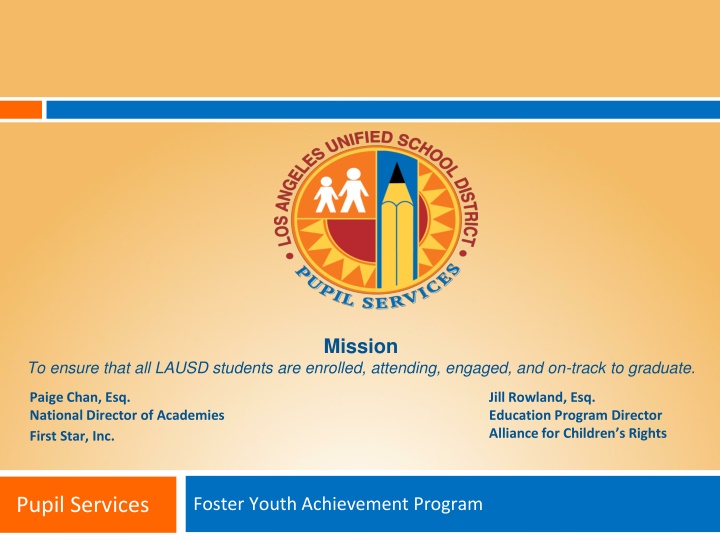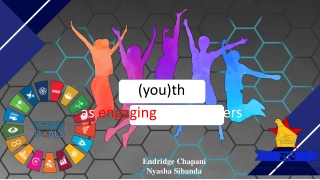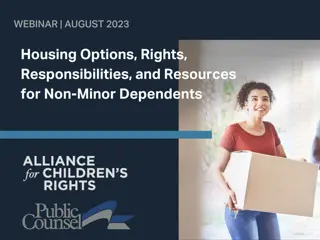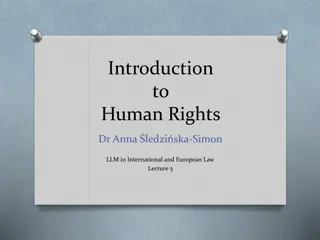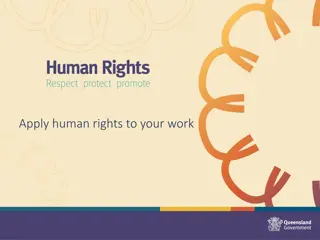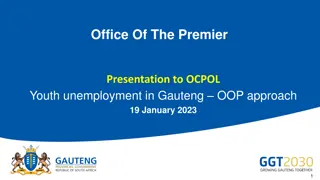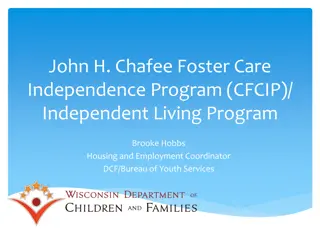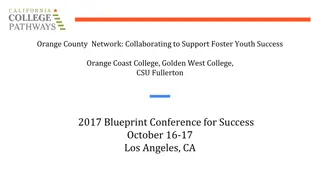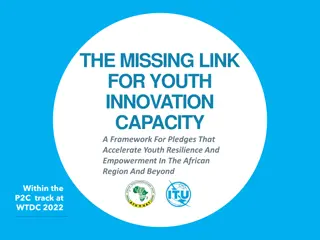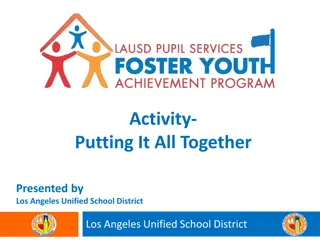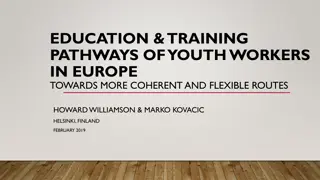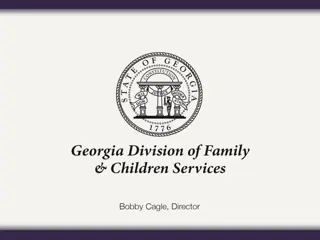Foster Youth Education Rights Overview
This content provides an overview of the education rights of foster youth in the Los Angeles Unified School District (LAUSD), including the definition of foster youth, identification processes, and the role of Education Rights Holders (ERH) in making critical education decisions for foster youth.
Download Presentation

Please find below an Image/Link to download the presentation.
The content on the website is provided AS IS for your information and personal use only. It may not be sold, licensed, or shared on other websites without obtaining consent from the author.If you encounter any issues during the download, it is possible that the publisher has removed the file from their server.
You are allowed to download the files provided on this website for personal or commercial use, subject to the condition that they are used lawfully. All files are the property of their respective owners.
The content on the website is provided AS IS for your information and personal use only. It may not be sold, licensed, or shared on other websites without obtaining consent from the author.
E N D
Presentation Transcript
Mission To ensure that all LAUSD students are enrolled, attending, engaged, and on-track to graduate. Paige Chan, Esq. National Director of Academies First Star, Inc. Jill Rowland, Esq. Education Program Director Alliance for Children s Rights Pupil Services Foster Youth Achievement Program
Overview School of Origin Records Transfer Partial Credits AB 167/216 High School Graduation Definition of Foster Youth Education Rights Holder Immediate Enrollment
Definition of Foster Youth Must have an open dependency court case (be subject to 300 or 309 petition) or delinquency case in criminal court (be subject to a 602 petition); It does not matter where youth live (e.g., foster home, group home, relative home, biological parent, juvenile hall or camp).
Are these youth foster youth? Brianna is living with her biological parents in a family maintenance arrangement. She and her parents attend dependency court every three months. Calvin was adopted through the dependency system three months ago. Eric s social worker came and made an informal placement with his grandmother, but did not open a dependency court case. Melanie was charged with theft and has an open delinquency court case, but is living with her parents. Starnisha is a 19 year old youth in extended foster care (AB 12) and is still in high school.
Identifying Foster Youth Each week, LAUSD receives a list of current foster youth from the Los Angeles Department of Children and Family Services. This list includes the placement, caregiver, and social worker, information gathered through DCFS s information system.
Education Rights Holders (ERH) All foster youth (regardless of age) must have an ERH ERHs have legal authority, granted by the court, to make education decisions for a youth Right to access education records and receive notice in specific situations Education decisions include but are not limited to: o Enrollment decisions o School of origin o Graduation planning o Special education o School discipline decisions affecting placement including Opportunity Transfers (OTs) and Community Day School (CDS) referrals
Who can hold education rights? Biological parents retain until court limits Adoptive Parents/Legal Guardians Relative caregiver, foster parent, CASA, community member with relationship to youth (e.g., mentor, coach) 18 year old youth Persons with a conflict of interest cannot hold education rights (e.g., social worker, group home staff, teacher/school employee, therapist, attorney, etc.)
Identifying a Youths ERH Review the LAUSD data-match list (LAUSD receives this list from DCFS each week) Contact the social worker/minor s attorney for foster youth or probation officer/public defender for probation youth o If you do not receive an answer, contact the person s supervisor Contact DCFS Education Unit at Youth.Education.Support@dcfs.lacounty.gov
Unresponsive or Inappropriate ERHs Common issues: o No ERH appointed after previous ERH s rights were limited o ERH unresponsive after several attempts to contact o Unwilling/inappropriate ERH (e.g., previous foster parent) Tips: o Group home staff cannot fulfill the role of an absent ERH o Use the ERH Request Letter to contact social worker/probation officer and minor s attorney/public defender for appointment of a new ERH o For youth with an IEP, work with Special Education Department to appoint a surrogate
Surrogate Parents Adult appointed by the school district to represent a youth s special education interests when they do not have an ERH ERHs are always better than surrogate parents, due to court s oversight Surrogates are a last option!
Activity 1: Education Rights Holders
Immediate Enrollment Overview of Law: o Foster youth must be immediately enrolled in school even if they do not have normally required records or school uniforms, or if they owe fines or fees to their previous school. o Youth must be enrolled in their local comprehensive school, unless (1) their IEP requires a more restrictive placement; (2) they are subject to formal disciplinary proceedings; or (3) their ERH consents to an alternative school placement. o Immediate enrollment also requires that youth be immediately placed in the same or equivalent courses they were enrolled in at their previous school
Immediate Enrollment Rationale for Law: o To reduce the losses caused by school transfers by ensuring minimal disruptions in enrollment and continuity in class placement. Procedures: o Grade placement o Course scheduling for high school students o Enrollment procedures for youth with IEPs o Access to extra-curricular activities
What would you do? Grandmother trying to enroll her granddaughter in school but she is more than 2 years off track for graduation Group home staff and social worker in your office trying to enroll a youth in school. The youth has some significant mental health and behavioral options and the social worker and group home staff are inquiring about smaller school settings for the student You work at a middle school and the dean of discipline has been constantly complaining about a foster youth with severe behavioral problems. You are getting pressured to call in the family and push the student out to the community day school A high school youth and his aunt walk into the front office to enroll in school. They fill out enrollment paperwork, including the foster youth screening questions. They answer yes that the youth lives with someone other than his parents. When you ask if the youth is in foster care, the aunt says no she doesn t think so.
Common Steps To Take Determine who holds education rights (this is your final decision maker regarding placement) Discuss all enrollment options including credit recovery or alternative program options (discuss both pros and cons of each school site) Discuss availability of additional services at each site (e.g., special education services, school based mental health counseling, positive behavior management programs) Ensure ERH understands right to enroll at local comprehensive school Implement ERH decision about placement Additional Notes: Need to be sensitive around students who do not self identify as residing in foster care Need to build positive/supportive school culture for these youth
School of Origin Intent: promote school stability o Activity: How many times did you change schools? Overview: Foster/probation youth have a right to attend their school of origin, unless their ERH determines it is in their best interest to transfer schools School of origin includes: o The school youth attend when they entered foster care; o The school youth last attended; and o Any school youth attended within the last 15 months with which they have a connection.
Additional School of Origin Rights Without regard to residence boundaries When their foster/probation case closes Matriculation/feeder patterns School of Origin and Individual Education Program (IEPs) Transportation Dispute resolution
School of Origin (SOO) Procedures Contact ERH to discuss (SOO Notification Letter) Convene a meeting/call with other relevant team members, including ERH (SOO Meeting Worksheet) Identify SOO(s) Discuss pros/cons Determine ERH SOO decision Determine transportation plan
Activity 2: School of Origin - Role Play Groups of 5 Utilize SOO Meeting Worksheet if helpful Can you come up with a solution that meets everyone s needs?
Records Transfer Requesting Records Upon Enrollment o Schools must request all records from previous school within 2 business days of enrollment. o Records are needed to ensure that youth are enrolled in the appropriate school, grade, and classes, and that any special education services are provided. Forwarding Records to New School o A copy of the youth s entire education file must be forwarded to the new school within 2 business days of receiving a request. o For high school students, this includes an official transcript with all classes, grades, and full/partial credits. o Records cannot be withheld for any fees, fines, or textbooks owed.
Records Transfer Releasing Records to ERHs o Any records requested by an ERH must be provided within 5 business days of receiving a request. Releasing Records to Social Workers/Probation Officers o County social workers/probation officers have a right to access a youth s records without a court order or ERH permission. Releasing Records to All Other Parties o Person requesting records must have a court order, subpoena, or written permission from the ERH.
Partial Credits: Intent Ensures that youth are not required to retake classes they previously completed Increases a youth s motivation o Even if youth have to transfer multiple times, or are in a school for only a short time, they remain motivated knowing they receive credit for their work. o By helping foster/probation youth gather their partial credits, and monitoring their academic progress, you are building a trusting and caring relationship with them! o Youth take pride in having one transcript that includes all classes and credits ever taken. Ensures youth remain on track for high school graduation
Partial Credits: Overview Foster/probation youth who transfer high schools mid-semester have a right to receive full or partial credits, based on in- seat time, for all work satisfactorily completed. o Must be issued on an official transcript upon withdrawal or within 2 days of records request from new school o Check-out grade: as of last day of actual in seat attendance (grades may not be lowered because of absences caused by placement changes, court appearances or court ordered activities) o Partial credits must be accepted by new school and applied to same/equivalent courses o Youth must be enrolled in same/equivalent courses o Youth may not be required to retake any portion of a course already completed if it would prevent them from remaining on track for high school graduation.
Procedures for Sending School Complete Student Transfer Form/Report o Triggered by formal withdrawal, notification that youth will not be returning o Work with teachers to ensure a final check out grade is issued based on all work completed as of last day of actual in-seat attendance Determine number of days of actual attendance for each class period (including block or variable length period schedules)
Calculate Credits Owed: Calculation Table Hours of Instruction # of Credits Earn 0-11 0 Credits 12-23 1 Credit 24-35 2 Credits 36-45 3 Credits 46-54 4 Credits 55-60+ 5 Credits
Procedures for Sending School Update Official Transcript o Add all grades and partial credits earned onto the youth s official transcript Complete upon disenrollment (and give to the youth and the adult disenrolling them) and/or Forward to a youth s new school within two (2) business days of receipt of their request for records
Procedures for Receiving School Request records within two (2) business days of enrollment o Make sure you receive: Transcripts from each high school Check out grades Enrollment/disenrollment dates Attendance records Assist the school to compile records to provide a comprehensive high school transcript
Procedures for Receiving School Review transcript and records to determine: o Any missing periods of enrollment/school history? Gaps of more than 10 days between disenrollment from one school and enrollment at another o Were partial credits appropriately issued? Determine partial credit policy of district which issued credits Count attendance and compute credits owed Check whether they were accurately issued
Procedures for Receiving School Retrieve Partial Credits o Send Partial Credit Request Letter o Follow up with registrar/counselor/AB 490 Liaison until credits are awarded on a transcript Update LAUSD transcript o Send all transcripts to current school and ensure everything is transferred onto 1 LAUSD transcript o Grades/credits must be applied to same/equivalent courses o Double check to ensure everything was updated appropriately
Procedures for Receiving School Ensure youth is enrolled in same/equivalent classes Assist the youth with credit recovery needs o Youth cannot be required to attend an alternative education site to make up credits unless ERH determines it is in their best interests o Youth cannot be required to retake any portion of a course already completed if it would prevent them from remaining on track for high school graduation o Youth have a right to retake any A-G required course for purposes of UC/CSU admissions, like any other student
Procedures for Receiving School Issue Additional Grades and Partial Credits at the End of the Semester o Calculation based on the number of periods attended per class after the youth s enrollment in the receiving school o Include on official transcript o Grades and partial credits previously awarded by the sending school for the current grading period should not be removed or averaged with the youth s grades and partial credits at the receiving school
AB 167/216 High School Graduation Overview o Foster youth who transfer high schools after their second year may graduate by completing minimum state graduation requirements if, at the time of transfer, they cannot reasonably complete additional school district requirements within four years. Intent o High school foster youth often transfer between school districts that have different graduation requirements. This law ensures foster youth are allowed to graduate on time even if they cannot complete additional classes that were not required at a previous school district.
Specifics of Law & Procedures AB 167/216 Identify whether student is a foster/probation youth o Open dependency or delinquency case o Does not matter where the youth lives Identify whether the youth completed second year of high school o Schools must use whichever method will make the youth more likely to be eligible: Length of enrollment or Number of credits earned Determine if school transfer occurred o Transfer must have occurred while the youth had an open dependency or delinquency court case.
AB 167/216 High School Graduation Determine if the youth is reasonably able to complete the LAUSD graduation requirements o Would the youth, taking the normal number of classes per semester, be able to complete all LAUSD graduation requirements by the end of 4 years of high school? o How to conduct reasonableness assessment: Count the number of remaining LAUSD credits required prior to graduation; Count the number of semesters remaining prior to the expected graduation date; Determine if, carrying a normal class schedule, the youth can complete the remaining credits in the remaining semesters.
AB 167/216 High School Graduation Notification of Eligibility and Graduation Options o Within 30 days of the youth s enrollment, the new school must send written notification to the youth, ERH, and CSW/PO of the youth s eligibility (or lack thereof) for AB 167/216 graduation. o The notification letter must outline: The youth s graduation options Impact on admissions for a four year university Transfer opportunities through community college
AB 167/216 High School Graduation o Graduation Options for Eligible Youth: Graduate under LAUSD requirements within 4 years of high school; Remain in high school for a 5th year and graduate under LAUSD requirements; Graduate under state minimum graduation requirements to receive a high school diploma. Decline to make a choice regarding graduation at this time. o See Sample Notification Letter
AB 167/216 High School Graduation Gathering ERH Decision o Only the youth s ERH can decide which graduation option to pursue. o An ERH can make a decision at the time of notification, defer making a decision, or later change their decision. Course Enrollment for AB 167/216 Youth o If an ERH accepts the exemption, then enroll the youth in the courses needed to complete state graduation requirements. o If an ERH decides the youth should remain in school for a 5th year, then the youth has a right to remain in the comprehensive high school even if s/he would be 19 years old. o A school cannot require youth to graduate before finishing 4 years of high school.
Minimum State Graduation Requirements English: 3 years Math: 2 years (including Algebra 1) Social Sciences: 3 years (World History, US History, US Government, Economics) Science: 2 years (Physical and Life Sciences) Visual/Performing Arts or Foreign Language: 1 year Physical Education: 2 years Note: To satisfy a year requirement, any two semesters in a related subject can be combined (e.g., Geometry A + Algebra 2B = 1 year of math)
Additional Provisions Length of Eligibility o Once a youth is found eligible, they remain eligible for exemption even if their case closes before they graduate or the youth transfers again. Reconsideration o If a youth was initially found ineligible, s/he can ask for reconsideration at any time. Requesting Transfers o A school district, youth, ERH, and social worker/probation officer cannot request a transfer solely to qualify for AB 167/216 graduation.
What would you recommend? Josh is now in 12th grade, but transferred high school at the start of 11th grade. He wants to attend UCLA, but at the end of this year he would be 15 credits short of completing his A-G requirements. Laura is eligible for AB 167/216 graduation. She has an IEP and currently only reads at a 5th grade reading level. Samantha is in her second semester of 12th grade, has 180 credits, and wants to attend Santa Monica Community College before transferring to UCLA. Jeremy has transferred schools 6 times in high school, currently has 175 credits, is in his second semester of 12th grade, and wants to join the military after high school.
Questions? Paige Chan, Esq. First Star, Inc. paige.chan@firststar.org Jill Rowland, Esq. Alliance for Children s Rights j.rowland@kids-alliance.org
